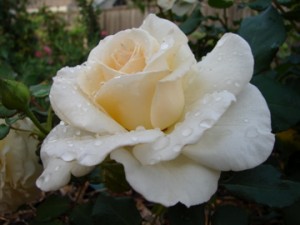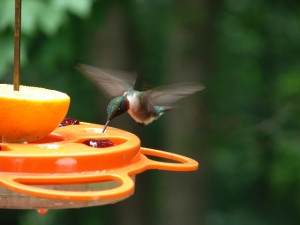Apr
20
What fun is gardening without butterflies? But to get an abundance of butterflies to come to your yard, you have to have the plants that they want and need – host plants and nectar plants.
Host plants are the plants that butterflies will lay their eggs on and then the hungry caterpillars will eat. Nectar plants are just that – plants that provide nectar as food for the adult butterflies. Some butterflies become very specific in the plants they need, especially for host plants. Monarchs need milkweeds, the Gulf Fritillary needs passionflower, and the Hackberry Butterfly needs hackberries.
Here are some host plants that are very specific for some Texas butterflies:

Monarch Caterpillar
- Milkweed (Monarch)
- Passionflower Vine (Gulf Fritillary)
- Hackberry (Hackberry butterfly)
- Sunflower (Patch Butterfly)
- Elm, Hackberry, nettle ( Question Mark)
- Citrus (Giant Swallowtail)
Here are some other great host and nectar plants that grow well in Texas :
- Asters – blooms late summer to fall
- Bee Balm (Bergamot) – blooms summer through fall
- Butterfly Bush (Buddleia) – blooms midsummer through fall
- Carrot – early spring or late fall
- Clover – blooms spring to fall
- Coreopsis – blooms summer to fall
- Cosmos – blooms summer to fall
- Dianthus – blooms spring to fall
- Dill – spring to fall
- Fennel – summer to fall
- Hollyhocks – blooms summer
- Impatiens – summer to fall
- Lavender – blooms spring to fall
- Lupine (including blue bonnets) – blooms spring
- Marigold – summer to fall

Monarch Chrysalis
- Mints – spring to fall
- Nasturtium – early spring and late fall
- Parsley – spring to fall
- Phlox – blooms late spring to fall
- Purple Coneflower (Echinacea) – blooms summer to fall
- Sage – blooms spring to fall
- Salvia – blooms late spring to fall
- Shasta Daisy – blooms late spring to fall
- Thistle – blooms spring to fall
- Yarrow – blooms late spring to fall
- Zinnia – blooms summer to fall
Basically, almost anything with a bloom can become a nectar plant including the dreaded dandelion.

Sam with a Monarch
For a list of butterflies of Texas, you can try The Butterfly Site and for an even more specific list for the DFW Metroplex you can try the Dallas Lepidoptera Society’s site. I also saw that the Texas Discovery Gardens will be hosting a “Butterfly Gardening Workshop” on Thursday, April 30. It costs $60 ($50 for members) but it looks like you get a lot for the cost of registration.
Other great resources are Gardens with Wings and Monarch Watch.
May the wings of the butterfly kiss the sun
And find your shoulder to light on,
To bring you luck, happiness and riches
Today, tomorrow and beyond.
~Irish Blessing
Apr
19
-
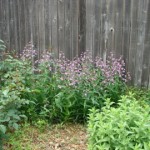
-
Stand of Gulf Coast Penstemon
-
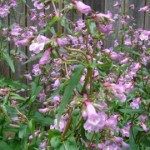
-
Gulf Coast Penstemon
This is the Gulf Coast Penstemon or sometimes called the Brazos Penstemon. The scientific name is Penstemon tenuis. It is a Texas native from the marsh areas. It does well in standing water and poorly drained soils, but I have also found it to be very drought tolerant. It is in a part of the yard that used to flood every year and has done quite well with that seasonal flooding where a lot of other plants wouldn’t have made it. I have it in partial shade, but I’m told that it can tolerate full sun.
These pictures were taken just a couple of days ago. The penstemon will bloom again in the fall and then die back to the ground through the winter and go dormant. They will also spread by seed if you want more but it hasn’t been very aggressive about it in my yard. If you don’t want it spreading, just cut the blooms when they are done. It attracts bees (this is a good thing), butterflies and hummingbirds!
Thanks for this one, Teresa. I love it!
Apr
19

Red Dragonfly
I love dragonflies. I once saw one take down a fly that was almost as big as it was. I love watching them. They are like little helicopters in their movements.
This one was a regular in our back yard a couple of years ago. As near as I can tell, it is some sort of skimmer – red skimmer, flame skimmer, neon skimmer. If there are any entomologists here, please help me to identify him. We get lots of little green and blue damselflies, but this is the one and only large red dragonfly we have had in our backyard. I’m hoping one will return this year.
Did you know that fossil records show that dragonflies have been around since prehistoric times? But back then they were huge! Much bigger than this guy. Here are a few more fun facts about dragonflies.
- Dragonfly eyes contain up to 30,000 individual lenses.
- They have two sets of wings. They don’t have to beat their wings in unison like other insects do. Their front wings can be going up while their backs ones are going down.
- Dragonfly nymphs (the first stage after hatching) live in the water for about a year.
- While underwater they eat mosquito nymphs, tiny fish, and pollywogs. When they have matured to airborne insects, they catch mosquitoes and gnats in mid-air before devouring them.
- After leaving the water and becoming flying insects, they only live for about a month.
- Their natural predators are birds.
Dragonflies are definitely worth encouraging in your garden! The biggest thing you can do to encourage dragonflies to your yard is to stop using pesticides. Stop poisoning them and their food and let them help you out with the pests in your garden. They will be much more specific in their bug killing efforts than any pesticide ever could.
Apr
17

Weeping Peach Trees

Peach Blossom
Peach trees are originally from China and thought to have made their way to the Mediterranean by way of the Silk Road. Who knows how they got to Texas.
This is a pair of weeping peach trees that I got from a friend that had to leave all of her plants behind when she moved. The pair is twisted together and they make a beautiful showing in the spring.
These are some pictures taken a couple of weeks ago. The blooms have already faded and the friut is starting to set.
The trees are only about four (five?) years old and we have yet to have edible peaches from them. That may be our fault though. Our two week trip in the summer tends to mess with things in our garden when it gets no water except what falls from the sky. Maybe this year there will be peaches.
Apr
17
A friend, Julie, asked to borrow a tiller the other day in order to till up part of her yard for a garden. I don’t till. I do have an antique tiller that worked quite well for my mother, but I’m too lazy (and environmentally conservative) to till. I don’t want to hurt my earthworms, who are prized friends in my garden.
I have another friend who swears by a system called double digging. If you want to know how to do that, you can find out here, but it is more work than I even want to think about.
Julie wrote back to me saying that she had thought about the worm aspect, but that her yard was hard clay with nothing growing in it for years. She did some research and came back with a brilliant plan that I had not heard of before. Her plan was to try naturally softening the top using rabbit food -alfalfa- on top of the dirt, cover with mulch such as straw, then top with a thin layer of organic substance (compost or hummus) and plant into it some native wild plants. The reasoning was that the rabbit food would attract worms to the surface to aerate the soil. while the mulch slowly decomposed releasing the good stuff into the top layer of soil. The plants-such as sunflowers, further aerate the oil and begin creating a symbiosis in the soil making it friendly to future planting. I love the idea!
Now, here are five reasons not to dig..

Now THAT'S an earthworm
- Not digging encourages the worms to do the work for you.
- Not digging reduces the loss of moisture (very important in Texas).
- Not digging protects the soil structure (think erosion)
- Not digging prevents weed seed from being brought to the surface to germinate
- Not digging is easier on the back.
And here are five reason you may want to go ahead and dig anyway…
- Digging breaks up heavily compacted soils and allows air back in to it.
- Digging kills surface weeds (although maybe not as well as suffocating them with cardboard).
- Digging exposes pests to predators and and temperature changes.
- Digging loosens things up for root vegetables to thrive.
- Digging is good exercise for those who want it (or are physically able).
Here are a few quick earthworm facts:
- Worms live where there is food, moisture, oxygen and a favorable temperature. If they don’t have these things, they go somewhere else.
- There are approximately 2,700 different kinds of earthworms.
- In one acre of land, there can be more than a million earthworms.
- The largest earthworm ever found was in South Africa and measured 22 feet from its nose to the tip of its tail.
- Worms tunnel deeply in the soil and bring subsoil closer to the surface mixing it with the topsoil. Slime, a secretion of earthworms, contains nitrogen. Nitrogen is an important nutrient for plants. The sticky slime helps to hold clusters of soil particles together in formations called aggregates.
- Baby worms are not born. They hatch from cocoons smaller than a grain of rice.
- Worms can eat their weight each day.
Apr
16

Veggie Garden
I love the smells in my garden. OK… the compost can sometimes smell strong and that bucket of weeds that has collected rainwater and then sat for a week is downright rank. But over all, the garden is filled with incredible smells. I love the way it smells when it rains or when the sun starts heating up the soil.
Walking through the garden, I can’t help but pet the rosemary and lavenders. I have to crush a bay leaf and take a big whiff. I’m constantly brushing and petting and smelling while I’m walking through my garden.
The flowers have a wonderful aroma that can’t be ignored. Each rose smells different and must have its due attention. The herbs call me even louder. Thyme, basil, sage, oregano, cilantro, dill, fennel, and mint. They make me hungry and sometimes I can’t resist nibbling on a small leaf here and there.
But the star of my garden… the one that makes me swoon… the one that transports me back to childhood, is the tomato plant. I get a whiff and suddenly I’m back in my mother’s garden in Kansas eating tomatoes off the vine as if they were apples.
Apr
16
In May 1917, President Woodrow Wilson wrote an open letter to the public published in The Garden Magazine. Here is an excerpt:
Every one who creates or cultivates a garden helps, and helps greatly, to solve the problem of feeding the nations… every housewife who practices strict economy puts herself in the ranks of those who serve the nation. This is the time for America to correct her unpardonable fault of wastefulness and extravagance…. Without abundant food, alike for armies and peoples now at war, the whole great enterprise upon which we have embarked will break down and fail.
This was addressed to the public just after the US entered World War II. Perhaps they were considered “The Greatest Generation” not because they fought a war, but because they, temporarily at least, turned away from the curse of greed and excess. Having too much is not a blessing and we have managed it poorly. President Wilson’s words still have merit today – maybe even more so.

Veggies
Apr
15
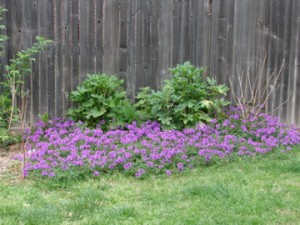
Trailing Verbena ('Homestead')
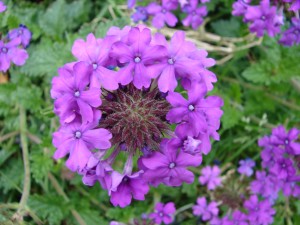
Trailing Verbena
This is a Purple “Homestead’ Verbena that I got from another gardening friend. It is the showiest thing in my garden from about the middle of February until the rest of the garden catches up in May or June. The foliage stays green all year here. I’m not sure if it is a Texas native or not. I know that there are a few verbenas that are native here.
Here is a brief description I found at Paghat’s Garden blog about it:
Homestead Purple is an heirloom hybrid that seems to have hybridized by chance in an old Atlanta Georgia garden. It is a cross between Verbena canadensis which is native of the American southeast ranging as far north as Iowa, pollinated by an unknown Verbena that had not survived in the Atlanta garden by the time a trained eye recognized the “otherness” of what was either a chance hybrid or long lost & forgotten cultivar.
The story of its rediscovery has become almost legendary. Alan Armitage is an authority on perennials, & Mike Dirr is an authority on woody shrubs. These two University of Georgia horticultural professors were driving back from a trip to Athens, Georgia, when they did a sudden U-turn to see what the heck was that amazingly colorful flower in an old homestead garden.
They knocked on the door but the woman who lived there only knew she had always had it in her garden. She shared starts with professors Dirr & Armitage, & from those a new popular verbena was introduced to the world.
The fragrant bright purple flowers are considerably larger than most Verbena, & are upon this perennial from May through all of summer right up to Autumn’s first frost or later. In warmer climates than ours blooms can start as early as March.
We have done absolutely nothing to ours other than throw a little organic fertilizer at it whenever we fertilize the lawn and it is a happy as can be. It will slow down in the heat of August and then start up again when the temperatures cool. It is incredibly drought tolerant. It is an absolutely lovely plant.











